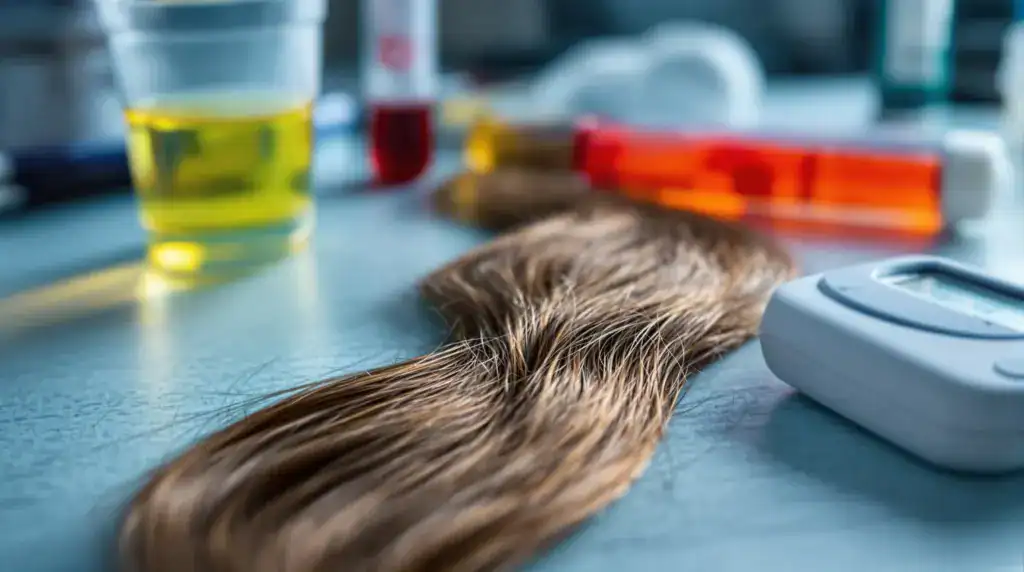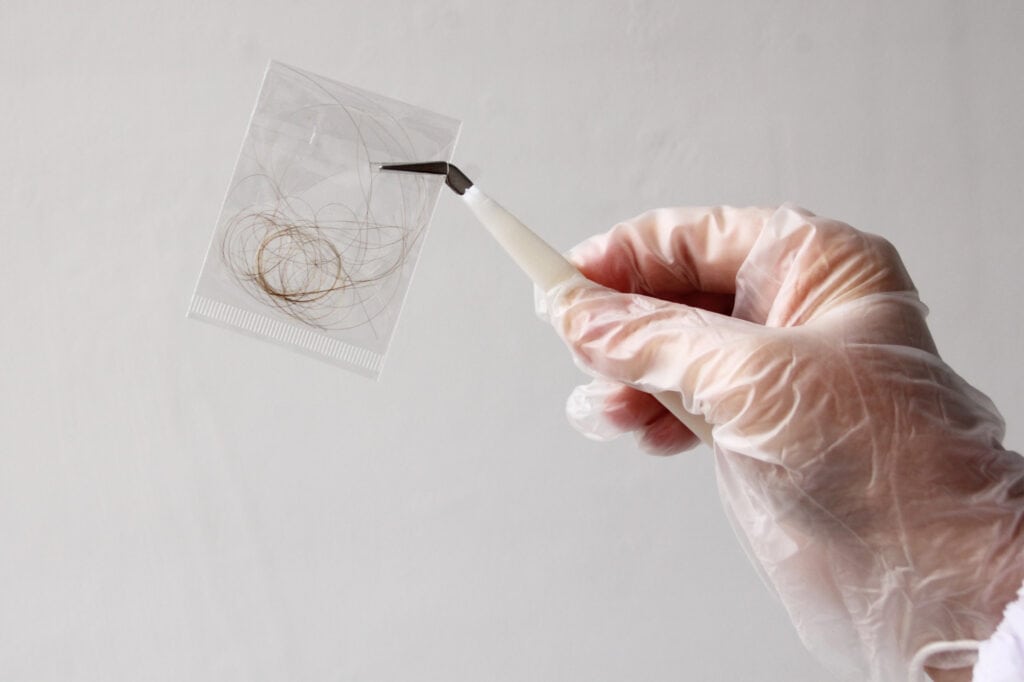This extended detection window makes hair testing particularly challenging if you’re facing employment screenings or legal proceedings. While cocaine disappears from your saliva within 24-48 hours and clears from urine in just four days, your hair tells a much longer story.
Several things affect how long cocaine can be found in your hair. These include how often you use it, how fast your body processes drugs, and even the length and growth rate of your hair. Knowing these factors can help you in situations where you might need to take a hair drug test.
Understanding Hair Follicle Drug Testing for Cocaine
Hair follicle testing is the best way to find out if someone has used cocaine over a long time. This kind of test gives police, employers, and treatment centers detailed information about your history with drugs that other tests cannot provide.
How Hair Testing Works
Hair testing detects cocaine by analyzing drug metabolites that become trapped within your hair shaft structure during growth. When you use cocaine, the drug enters your bloodstream and circulates throughout your body, including reaching your hair follicles. As your hair grows, it incorporates these cocaine metabolites into its keratin structure.
Testing laboratories typically collect a 1.5-inch sample of hair from the crown of your head, which represents roughly 90 days of hair growth. The collected sample undergoes a two-step analysis process: an initial screening test followed by a confirmatory test using gas chromatography-mass spectrometry (GC-MS) for accurate results.
Unlike other testing methods that detect the parent drug, hair tests identify specific cocaine metabolites such as benzoylecgonine and cocaethylene. These metabolites remain stable within your hair structure and resist removal through normal washing or environmental exposure.
Detection Window for Cocaine in Hair
| Testing Method | Detection Window | Cocaine Metabolites Detected |
| Hair Follicle | 90 days (standard) | Up to 12 months (longer hair) |
| Urine | 4 days | 1-3 days (occasional use) |
| Saliva | 24-48 hours | 12-24 hours |
| Blood | 12-24 hours | 6-12 hours |
Cocaine can be detected in hair for varying lengths of time based on several factors. Standard hair tests generally identify cocaine use for up to 90 days after the last use, but it can be detectable for up to 6 months, especially in longer hair.
The length of hair affects how long cocaine stays detectable. Hair longer than 1.5 inches can show positive results for cocaine use beyond the usual 90 days, while very short hair may reduce detection periods due to the removal of drug-containing hair. Detection starts 7-10 days after use, as it takes time for hair to grow above the scalp. Thus, recent cocaine use within the last week might not show up in hair tests, unlike urine or saliva tests.
Factors That Influence Detection Time in Hair
Multiple variables affect how long cocaine stays in your hair, with detection windows ranging from 90 days to 6 months, depending on your usage patterns and physical characteristics. Understanding these factors helps explain why cocaine detection times vary significantly between individuals.
Frequency and Amount of Use
Heavy and frequent cocaine use creates higher concentrations in your hair shafts, potentially extending the detection window beyond the standard 90-day period. Occasional or light use results in lower drug concentrations and shorter detection times, as cocaine metabolites accumulate less densely within the hair structure.
Chronic users often face detection periods approaching 6 months, while single-use instances may clear from detectable levels within the minimum 90-day window. The cumulative effect of repeated cocaine exposure means your hair follicles continuously incorporate drug residues, creating a more persistent chemical signature that testing laboratories can identify months later.
Hair Growth Rate and Color
Your hair’s natural growth rate directly impacts how long cocaine stays in your hair follicles. Faster growth rates push drug deposits farther from your scalp more quickly, potentially shortening the detection window as older hair segments containing cocaine move away from the tested root area.
Hair color significantly influences cocaine retention, with darker hair containing higher melanin levels that bind more drug metabolites. This characteristic means cocaine markers accumulate more readily in darker hair than lighter hair, potentially increasing both detectability and retention times.
Chemical Treatments and Hair Damage
Chemical processes like bleaching, dyeing, perming, and relaxing treatments can reduce cocaine concentrations in your hair strands by degrading drug metabolites. These treatments may lower detectability or shorten detection windows, though they rarely eliminate all traces completely.
Repeated chemical treatments create cumulative damage that breaks down the hair’s structural integrity, potentially releasing bound cocaine metabolites. But, laboratories account for these variables during testing, and heavily processed hair may still retain detectable levels of cocaine for extended periods. Swimming in chlorinated pools and exposure to harsh environmental conditions can also affect cocaine retention, though to a lesser degree than direct chemical treatments.
How Cocaine Metabolizes in Hair Follicles
When cocaine gets into your bloodstream, your body breaks it down in a complicated way. This process decides how long cocaine can be found in hair. The liver changes cocaine into different substances, with benzoylecgonine (BZE) being the main one that drug tests look for.
Cocaine vs. Benzoylecgonine Detection
Hair tests check for both cocaine and benzoylecgonine to be more accurate. Benzoylecgonine is made when your liver processes cocaine and stays in your body much longer than cocaine itself. This substance gets into your hair through blood flow and from sweat and oils around the hair follicle.
Testing labs look at the amount of benzoylecgonine compared to cocaine to tell if someone really used cocaine or if it just came from the environment. If the benzoylecgonine-to-cocaine ratio goes above 5%, it usually shows real cocaine use instead of just being around it. This ratio goes up over time, peaking about 5 days after using cocaine.
Your hair might also have hydroxycocaines (2-, 3-, and 4-OH-cocaine), which are made during the breakdown of cocaine or can come from the environment. These extra substances help labs find more signs of cocaine use and understand how often it was used.
Comparing Hair Tests to Other Drug Testing Methods

Hair follicle tests offer significantly longer detection windows than other cocaine testing methods, making them valuable for identifying historical drug use patterns. Understanding these differences helps you recognize why employers and legal professionals often prefer hair testing over alternative methods.
Hair vs. Urine Testing
Urine tests detect cocaine metabolites for 2-4 days after use, with heavy users potentially testing positive for up to one week. Hair follicle tests extend this detection window dramatically, revealing cocaine use for 3-6 months depending on hair length and growth patterns.
| Detection Method | Timeframe | Primary Use Case |
| Urine Testing | 2-4 days (up to 1 week for heavy use) | Recent use detection, workplace screening |
| Hair Testing | 3-6 months (90+ days standard) | Historical use patterns, pre-employment screening |
Urine tests analyze benzoylecgonine, cocaine’s primary metabolite, which clears from your system relatively quickly. Hair tests detect both cocaine and benzoylecgonine embedded within the hair shaft, creating a permanent record of use that remains until you cut your hair.
The key advantage of urine testing lies in detecting very recent cocaine use within 24-48 hours. Hair testing requires 7-10 days for cocaine-containing hair to emerge above your scalp, making it ineffective for identifying immediate consumption.
Chronic users face extended detection periods with both methods. While urine tests may detect cocaine for up to two weeks in heavy users, hair tests can reveal usage patterns spanning several months, providing a comprehensive view of long-term consumption habits.
Hair vs. Blood and Saliva Testing
Blood tests offer the shortest detection window, identifying cocaine for only a few hours to 1-2 days after use. Saliva tests detect cocaine for 1-36 hours, with some cases extending to 2-3 days maximum.
Hair follicle testing surpasses both methods significantly, maintaining detectability for months rather than days or hours. This extended timeframe makes hair testing ideal for situations requiring comprehensive drug use history rather than immediate detection.
| Test Type | Detection Window | Best Application |
| Blood | Few hours to 2 days | Current intoxication, medical emergencies |
| Saliva | 1-36 hours (up to 3 days) | Roadside testing, recent use screening |
| Hair | 3-6 months | Employment screening, custody cases |
Blood tests detect cocaine in its original form before metabolic breakdown occurs, making them useful for determining active intoxication levels. Saliva tests offer quick, non-invasive screening capabilities, making them ideal for immediate assessment situations.
The combination of hair and urine testing creates comprehensive coverage across different timeframes. While blood and saliva tests excel at detecting recent use, hair testing reveals patterns that shorter-window tests might miss entirely.
Hair color affects detection sensitivity, with darker hair retaining cocaine metabolites more effectively than lighter hair due to the binding of melanin. Chemical treatments like bleaching or dyeing can reduce detectability in hair tests but rarely eliminate traces completely, maintaining the method’s reliability advantage over temporary detection methods.
Limitations and Accuracy of Hair Follicle Tests
Hair follicle tests face several accuracy challenges that can affect how long cocaine stays in your hair follicles and the reliability of results. Understanding these limitations helps you interpret test outcomes correctly and recognize potential complications in detection windows.
False Positives and External Contamination
External contamination represents the most significant challenge in determining how long cocaine stays in hair through testing methods. Environmental exposure can deposit cocaine residues on your hair surface without actual drug consumption, particularly affecting children who experience passive exposure to contaminated environments.
- Direct contact with cocaine powder or contaminated surfaces transfers drug residues to hair externally
- Environmental smoke from crack cocaine use deposits particles on nearby individuals’ hair
- Secondary transfer from handling contaminated objects or surfaces before touching hair
- Workplace exposure in law enforcement or medical settings where cocaine handling occurs
Laboratories fight contamination by using advanced tests that check for specific substances like hydroxycocaine. This chemical shows up only when someone uses cocaine, not from touching it. This means it helps detect real drug use instead of just surface contamination. If the ratio of benzoylecgonine to cocaine is above 5%, it usually means the person actually used the drug, not just came into contact with it.
Chemical hair treatments also make it harder to check for contamination. Bleaching and dyeing can wash away surface dirt and damage internal substances, making it tough to tell if a negative test result is because of the treatment or if the person hasn’t used drugs at all.
What to Expect During a Hair Follicle Drug Test
Hair follicle drug testing follows a standadized procedure that ensures accurate detection of cocaine metabolites in your hair sample. The process begins with a trained technician collecting approximately 100-120 strands of hair from the crown of your head, which represents about 1.5 inches of hair length and covers roughly 90 days of drug history.
Sample Collection Process
Collection takes place in a controlled environment where the technician cuts hair close to your scalp using sterile scissors. The sample comes from multiple areas of your head to ensure adequate coverage and prevent obvious bald spots. If your head hair is insufficient due to length or availability, technicians can collect body hair from your arms, legs, chest, or underarms as an alternative.
Laboratory Analysis Procedures
Your hair sample undergoes a two-step analysis process at certified laboratories. The initial screening uses enzyme-linked immunosorbent assay (ELISA) technology to identify potential positive results for cocaine metabolites. Samples that screen positive advance to confirmatory testing using gas chromatography-mass spectrometry (GC-MS), which provides definitive identification and quantification of specific cocaine metabolites.
Laboratories specifically test for benzoylecgonine (BZE), the primary metabolite produced when your body processes cocaine. This metabolite remains stable in hair structure and resists external contamination, making it the most reliable indicator of actual cocaine consumption rather than environmental exposure.
Timeline and Results
Hair follicle drug tests typically require 3-5 business days for complete analysis and results. The testing facility analyzes the 1.5-inch section closest to your scalp, which corresponds to approximately 90 days of hair growth based on the average growth rate of 0.5 inches per month.
Results appear as either positive or negative, with specific cutoff levels determining the outcome. For cocaine, laboratories use a cutoff concentration of 500 picograms per milligram of hair for screening tests and 100 picograms per milligram for confirmatory testing.
What Happens If Your Test Is Positive
Positive results undergo additional scrutiny through the medical review officer (MRO) process, where a licensed physician reviews your results and medical history. The MRO contacts you to discuss any legitimate medical explanations for the positive result before releasing the final report to the requesting party.
Chain of custody documentation tracks your sample throughout the entire process, ensuring the integrity and authenticity of results. This documentation becomes crucial if legal challenges or disputes arise about the test outcome.
Ready to Take Next Steps?
Cocaine can remain in your hair for months, making it one of the longest detection methods available. If you’re ready to move beyond worrying about tests and start building a healthier future, Assure Recovery is here to help. Contact us today at 833-530-0291 or visit our Contact Us page to take the first step toward lasting recovery.
FAQs
Hair follicle testing raises specific questions about cocaine detection and test preparation. These frequently asked questions address the practical aspects of how long cocaine stays in hair follicles and what you can expect during testing.
Hair tests are considered one of the most reliable methods for detecting long-term cocaine use. They can often detect use up to 90 days after the last dose, though accuracy may depend on factors like hair type, length, and frequency of drug use.
No. Washing, bleaching, or dyeing your hair will not reliably remove cocaine metabolites from the hair shaft. Since the drug is trapped inside the structure of the hair as it grows, external cleansing methods are ineffective.
Yes. Because hair grows about half an inch per month, longer hair provides a longer timeline of drug use. However, most tests only analyze the first 1.5 inches closest to the scalp, giving an approximate 90-day detection window.
Sources
National Institute of Justice. (2024, June 4). Detecting drugs in hair: Is it drug use or environmental contamination? U.S. Department of Justice. Retrieved from https://nij.ojp.gov/topics/articles/detecting-drugs-hair-it-drug-use-or-environmental-contamination


